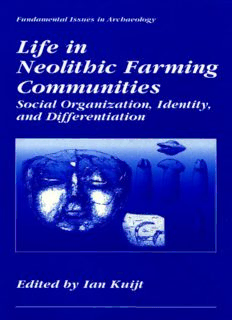
Life in Neolithic Farming Communities - Social Organization, Identity, and Differentiation (Fundamental Issues in Archaeology) PDF
Preview Life in Neolithic Farming Communities - Social Organization, Identity, and Differentiation (Fundamental Issues in Archaeology)
Life in Neolithic Farming Communities Social Organization, Identity, and Differentiation FUNDAMENTAL ISSUES IN ARCHAEOLOGY Series Editors: Gary M. Feinman The Field Museum, Chicago, Illinois T. Douglas Price Universityof Wisconsin-Madison EditorialBoard: OferBar-Yosef,Harvard University • ChristineHastorf, UniversityofCalifornia-Berkeley • JeffreyHantman, Universityof Virginia • PattyJoWatson, Washington University • LindaManzanilla, Universidad Nacional Autónoma deMéxico • JohnParkington,Universityof Capetown • KlavsRandsborg, UniversityofCopenhagen Olga Soffer, University of Illinois • MatthewSpriggs, Australian National University • JohnYellen, National ScienceFoundation EMERGENCEAND CHANGEIN EARLYURBAN SOCIETIES Edited by LindaManzanilla FOUNDATIONSOF SOCIALINEQUALITY Edited by T. Douglas Price and Gary M. Feinman LEADERSHIPSTRATEGIES,ECONOMICACTIVITY,AND INTERREGIONAL INTERACTION SocialComplexityin Northeast China Gideon Shelach LIFE IN NEOLITHIC FARMING COMMUNITIES SocialOrganization,Identity, andDifferentiation Edited by Ian Kuijt AContinuationOrder Plan isavailable for this series. Acontinuationorderwillbringdeliveryof eachnewvolumeimmediatelyupon publication. Volumesarebilled only uponactualshipment. For further information please contact the publisher. Life in Neolithic Farming Communities Social Organization, Identity, and Differentiation Edited by I K AN UIJT Universityof Notre Dame NotreDame, Indiana KLUWER ACADEMIC PUBLISHERS New York Boston Dordrecht London Moscow eBook ISBN: 0-306-47166-3 Print ISBN: 0-306-46122-6 ©2002 Kluwer Academic Publishers New York, Boston, Dordrecht, London, Moscow All rights reserved No part of this eBook may be reproduced or transmitted in any form or by any means, electronic, mechanical, recording, or otherwise, without written consent from the Publisher Created in the United States of America Visit Kluwer Online at: http://www.kluweronline.com and Kluwer's eBookstore at: http://www.ebooks.kluweronline.com Contributors OferBar-Yosef Department of Anthropology, Harvard University,Cam- bridge, Massachusetts 02138 Anna Belfer-Cohen Department of Prehistory,Institute of Archaeology, Hebrew University,Jerusalem,Israel 91905 BrianF.Byrd ASMAffiliates,543EncinitasBoulevard,Suite114,Encinitas, California 92024 and Department of Anthropology, University of Cali- fornia, SanDiego,LaJolla, California 92093-0532 JacquesCauvin CentreNationaldela RechercheScientifique,Institutde Prehistoire Orientale,Jalès, France Avi Gopher Institute of Archaeology,University ofTelAviv,RamatAviv, Israel 69978 Nigel Goring-Morris Department of Prehistory,Institute of Archaeology, Hebrew University,Jerusalem,Israel 91905 Frank Hole Department of Anthropology, YaleUniversity,New Haven, Connecticut06520-8277 Ian Kuijt DepartmentofAnthropology,University of NotreDame,Notre Dame,Indiana 46556 Estelle Orrelle Institute of Archaeology, University of Tel Aviv, Ramat Aviv,Israel 69978 v vi CONTRIBUTORS Richard W Redding Museum of Anthropology, University of Michigan, Ann Arbor, Michigan 48109 GaryO.Rollefon 'AinGhazal Research Institute, 64372Ober-Ramstadt, Germany MichaelRosenberg DepartmentofAnthropology,UniversityParallel Pro- gram,University of Delaware, Newark, Delaware 19716 AlanH.Simmons Department ofAnthropologyandEthnic Studies,Uni- versity of Nevada,LasVegas,Nevada 89154-5012 Mary M. Voigt Department of Anthropology, College of William and Mary,Williamsburg, Virginia 23187-8795 Preface Thisvolume emerged from an increasing awareness amongarchaeologists that while researchers have explored some of the technological, subsis- tence, and economic dimensions of the Near Eastern Neolithic,far less at- tentionhasbeen paid tounderstanding thenatureof socialorganizationfor thisimportantperiod. Inrelation to othertopics,ithasonlybeen inthelast 20years or sothat researchers have started tostudythe nature of Neolithic social organization in any detailed fashion. Given that the Neolithic pro- vides our earliest case studies for how food production, social differentia- tion, and population aggregation and growth are interrelated, it is all that much more surprising torecognize that asarchaeologists we donot have a comprehensive understanding of some of the social foundations within Neolithic communities. Archaeologists, for example, have only a limited understanding of how the household servedasa socialandeconomicunit, howkinship mighthavebeen organized,orthedegreetowhich leadership was identified, shared, and allocated within communities. The breadth of research in this volume furthers our understanding of the Neolithic as an economic event,opening up what is unquestionably the Pandora’sbox of the Neolithic: studying the dynamic nature of social arrangements, how these behaviors were linked to material culture, and how they help us understand the trajectory of life within Neolithiccommunities. Ultimately, addressingtheseissuesisnotonlychallenging,but itrequiresfocusingnew attentiononissuesof socialagency andunderstanding how differentsocial practices may havebeen employed to define,shape,andmanipulate iden- tities at the household, kin-group, and community level.Thistentative ex- ploration of human agency,while still in its infancy, represents an impor- vii viii PREFACE tant departure from previous studies, requiring an interpretive framework based on Neolithicdata sets. Sixof the chapters inthisvolume were originallywritten for a sympo- sium,titled “SocialConfigurationsof Near EasternEarlyNeolithic:Commu- nity Identity, Heterarchical Organization, and Ritual,” held in 1995 at the SixtiethAnnualMeetingforthe Societyof AmericanArchaeologyinMinne- apolis,Minnesota. Buildingon this foundation, these original studies have been expanded and five other chapters have been incorporated into the volumeto address complementarydimensionsof Neolithicsocialorganiza- tion. In this collection, researchers synthesized recent anthropological and archaeologicalthought concerningthevariationwithin-andthenatureof- Neolithic social arrangements. Drawing on both the results of recent ar- chaeological research aswell asanthropologicaltheory,the authors recon- structkeyaspectsofritualpractices,labororganization,andcollectivesocial identityatthescaleof thehousehold,community, andregion.Thechapters encompass a rangeof methodological andtheoretical perspectivesanduti- lize innovative analytic approaches in the study of mortuary, settlement pattern, and architectural data to better understand the processes of (and reasons for) specificsocialarrangementsand ritual andmortuary practices. Assuch, eachofthecontributingauthorsstruggleswiththehighlycomplex, and often avoided, interpretive interface between archaeological data sets and socialinterpretation of the Neolithicof the Near East.Thegoals of this volume, therefore, are not to reject traditional or other important research agendas nor to enforce a specifictheoretical or methodological approach. Rather, this collection is envisioned as a vehicle by which discussion of other social dimensionsof the Neolithiccan be brought to the attentionof archaeologists, anthropologists, and prehistorians to enhance the existing reconstruction of this fascinating period of time. Mythanksgototheparticipants intheoriginalsymposium,thepartici- pation by the audience during the symposium, and the other researchers who agreed to contribute to this book. The addition of these papers has greatlyexpandedthescopeandnatureof discussion,debate,andreflection on a wide range of theoretical and methodological issues related to the nature of socialorganization of the NearEasternNeolithic.Thepreparation ofthisvolume,aswellasthetaskof organizingtheoriginalsymposium,has been facilitatedby the enthusiasm,interest,andenergyof allof the partici- pants.Beyondthislist,Iwould liketothankOferBar-Yosef,HermanMakler, C. C. Lamberg-Karlovsky, T. Douglas Price, and Gary Feinman for their active support with the publication of this volume. It was Ofer who first pushed metoorganizetheoriginalsymposiumandT.Douglaswhopushed this work at Plenum and introduced me to Eliot Werner.Thanks are also PREFACE ix give to Eliot Werner, Archaeology Czarat Plenum,who has made the pro- cesses of negotiation and publication a direct,honest, and enjoyable task. Publication ofthisworkwasfacilitated bycriticalfinancialsupportfromthe American School of Prehistoric Research, support that I am most grateful for.Thecoverartwork kindlyprovided by NigelGoring-Morris andMichael Rosenberg is from their excavations at Kfar HaHoresh and Hallan ‚ emi. Finally,IwanttoexpressmythankstoMeredith S.Chesson,mywife,friend, andmate,whoservesasa continuingsourceof advice,help,patience, and support. It is to her that this book is dedicated.
Description: